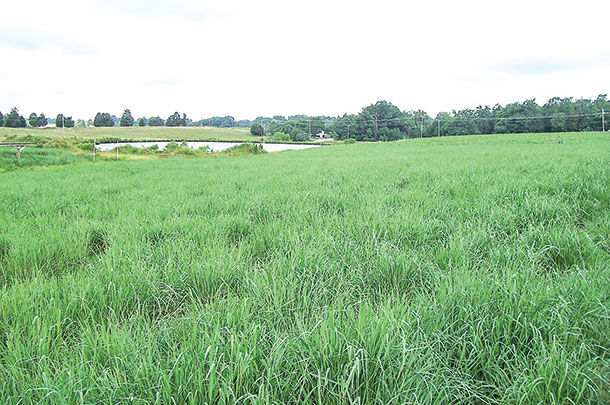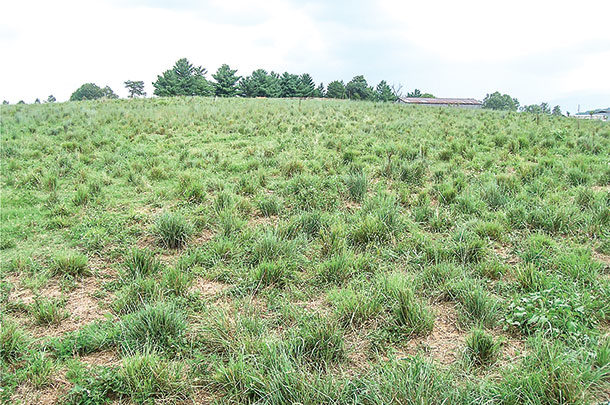First, the more vigorous the grass stand, the fewer problems you will have with weeds. Second, fertility must be maintained at appropriate levels. Where weeds have become a problem, herbicide options for native grasses are generally similar to the other species mentioned above. Let’s discuss each of these issues.
Maintaining vigorous stands of native grasses is really no different than for any other grass species. It all comes down to canopy management. Although it is important to keep any forage from getting too tall (i.e., mature) for quality reasons, it is too much grazing pressure (and especially having too much grazing pressure for extended periods) that negatively impacts stand vigor.
Remember, the root volume of a grass plant is typically a mirror image of the aboveground growth. So when a stand is grazed too short, roots are weakened and the plants take much longer to recover and become competitive. Weeds take advantage of this “open door” to become established and compete with the weakened grasses. The longer the overgrazing continues, the worse the situation will become.
The only difference with native grasses and other common forage grasses is the target grazing height. By leaving native grass canopies above 12 to 16 inches tall (depending on the species or variety), plants will have ample leaf-surface area (the grasses’ “factory”) and remain vigorous.
Another time when native grass stands can be weakened and the door opened for weed encroachment is in late summer or early fall. This is a strategic time for native grasses because they require some late-season rest prior to fall dormancy.
This rest allows the perennial natives to rebuild root energy reserves – something needed to ensure overwinter respiration needs are met and adequate reserves are available for vigorous growth the following spring. Grazing too late (after early to mid-September) or taking late hay cuttings (after mid- to late August) can preclude any rest, weaken stands and allow weed pressure to develop.
Fertility also impacts weed pressure through its influence on stand vigor. Pastures and hayfields with optimum fertility and pH levels allow grasses to reach their full growth potential.
For native grasses, that level is well below what we think (in terms of other common forage species). Inputs above the point of diminishing returns (80 to 100 units of nitrogen per acre) will simply end up fertilizing weeds. For eastern gamagrass, the nutrient input threshold is much higher and is comparable to improved bermudagrass.
Where weeds have reached levels where control measures need to be taken, treatment in established native grass stands (second-year or after) will be similar to that for other forage grasses.
Most broadleaf weeds will be controlled readily with herbicides such as 2,4-D, dicamba (Weedmaster), metsulfuron (Cimarron Plus) and aminopyralid (GrazonNext HL) products. For some grass weeds (e.g., annual foxtails, broadleaf signal grass, vasseygrass), another option is imazapic-based products (Plateau or Panoramic), but not for switchgrass, which will be damaged by imazapic.
If johnsongrass needs to be controlled – a problem more likely to develop in a hay-production setting rather than in pastures – that can be accomplished with imazapic or, for switchgrass, with sulfosulfuron (OutRider).
Woody plants can be controlled with products containing triclopyr (PastureGard), picloram (Grazon P+D) or aminopyralids (Chaparrall).
With the warm-season native grasses, the dormant season provides another opportunity to control weeds. Once the natives have become dormant, typically after mid-October and certainly after a killing frost, broad-spectrum herbicides such as glyphosate can be used without any concern for damaging the stand.
Spraying glyphosate after dormancy breaks in the spring (typically about April 1) can injure the native grasses. However, switchgrass has a remarkably high tolerance to glyphosate in the spring, and treatment with a low rate (1 quart per acre) can be used following dormancy break without injury.
Dormant-season sprays can be useful for controlling encroaching cool-season grasses (e.g., bromes, tall fescue and orchardgrass) that can weaken native grass stands through spring competition. Fall and spring are also excellent times for controlling weeds such as thistles and plantains.
Common bermudagrass cannot be easily controlled in a native grass stand and can become a serious problem. Cattle prefer the native grasses and because they do not graze the bermudagrass within native pastures, it will continue to spread.
Common bermudagrass provides lower rates of gain than native grasses, is less drought-tolerant and offers no advantages in terms of stocking rates. Like any other weed, keeping it from getting started is the best strategy. Keeping it out of the stand with good establishment practices and maintenance of vigorous native grasses are the best approaches.
There are no herbicides that can be used on bermudagrass that will control it without damaging the native grasses as well. However, there are some things that can give native grasses a greater competitive advantage.
First, reduced nitrogen inputs favor the less nutrient-demanding native grasses. Second, a spring (mid-May) application of a high rate of imazapic may also help suppress the bermudagrass. Finally, allowing the taller native grasses to grow up for a full season – perhaps with a single hay cutting in early summer – can help suppress the bermudagrass through shading.
Two other weed control tools that can be used with natives are grazing management and fire. For grazing management to be effective, heavy stocking rates for short durations can control species that may not be desirable forages at later stages of maturity but are palatable when young (e.g., common ragweed). This does not need to be “mob grazed,” as such, but heavy enough stocking to quickly suppress the target weed.
Fire is a tool once widely used on pastures in the Southeast and still commonly used in many parts of the Great Plains on native rangeland. Native grasses are very fire-adapted and can respond well to periodic burning. Depending on timing, fire can provide very effective weed control. Burning can destroy all annuals, young perennials and even weed seeds in the thatch layer.
For warm-season native grasses, a late March or early April burn is the best timing. Such fires eliminate cool-season annuals, suppress cool-season perennials and give natives a “jump- start” at a time when they are poised to begin their spring growth. This jump-start is a result of two things. First, the fire blackens the soil and removes the insulating thatch layer.
Together, these factors allow soil to warm more quickly, giving the natives an earlier start on spring growth. Second, the fire releases nutrients into the soil that had been bound up in the thatch; this includes both nitrogen and phosphorous. The more rapid growth of the native grasses and the elimination of existing competition allow the natives to quickly dominate the site – a situation that also tends to reduce development of warm-season annuals.
Because switchgrass is such a vigorous species, it typically does not develop as many weed problems as some of the other native grasses. I recently inspected some switchgrass pastures planted in 2008 and 2009 that have been grazed each summer since, and they were remarkably clean – and have had no weed control since the establishment year.

Because of the shorter growth form of bluestems, weeds can become more easily established.
Similarly, eastern gamagrass stands, because of the large size of individual plants, can have fairly open stands that can more easily become weedy. However, in all cases, the guidelines provided above can go a long way toward keeping native grass forages productive and input costs down. And that adds up to economical production of high-quality summer forages – something that will benefit any producer. FG
PHOTO 1: Continued close grazing of bluestems or indiangrass can leave ample sunlight and space available for weeds to become established and later compete with the grasses. Retaining ample canopies (12 to 15 inches or taller) will allow the native grasses to dominate the site more fully and save money on spraying.
PHOTO 2: Switchgrass is a tall-growing species that, once established, can be very competitive. Research pastures at University of Tennessee have been grazed for seven years (since establishment) and have not required weed control in most cases. This pasture has remained largely weed-free. Photos courtesy of Pat Keyser.

-
Patrick Keyser
- Center for Native Grasslands Management
- University of Tennessee
- Email Patrick Keyser








